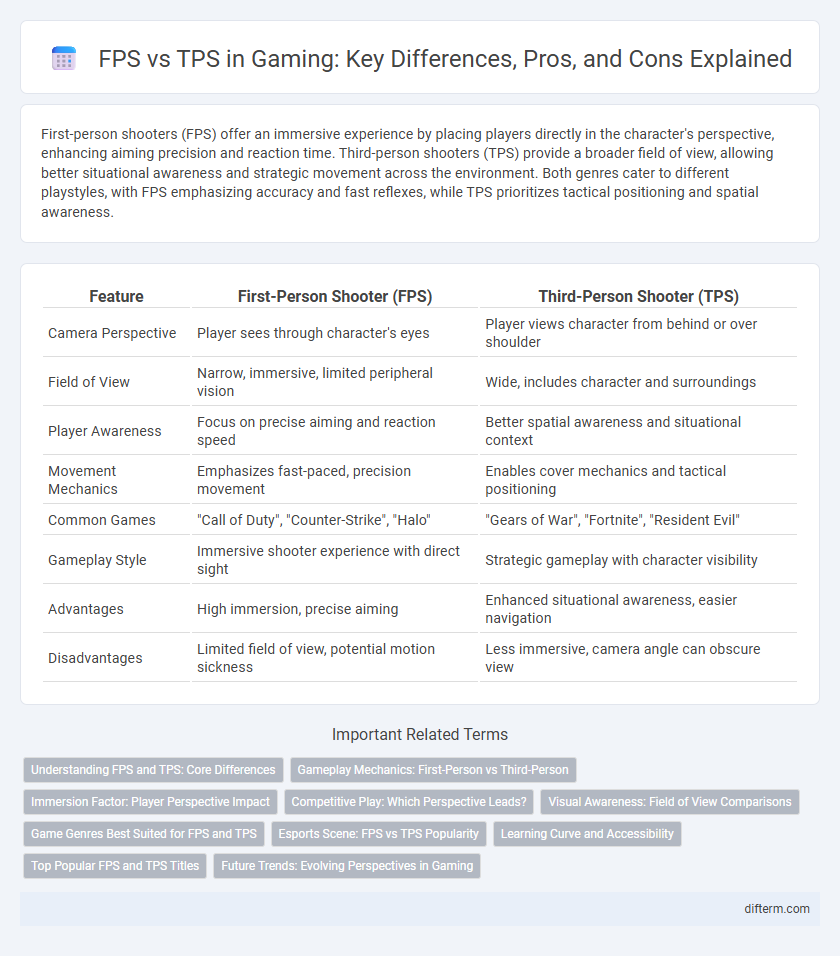First-person shooters (FPS) offer an immersive experience by placing players directly in the character's perspective, enhancing aiming precision and reaction time. Third-person shooters (TPS) provide a broader field of view, allowing better situational awareness and strategic movement across the environment. Both genres cater to different playstyles, with FPS emphasizing accuracy and fast reflexes, while TPS prioritizes tactical positioning and spatial awareness.
Table of Comparison
| Feature | First-Person Shooter (FPS) | Third-Person Shooter (TPS) |
|---|---|---|
| Camera Perspective | Player sees through character's eyes | Player views character from behind or over shoulder |
| Field of View | Narrow, immersive, limited peripheral vision | Wide, includes character and surroundings |
| Player Awareness | Focus on precise aiming and reaction speed | Better spatial awareness and situational context |
| Movement Mechanics | Emphasizes fast-paced, precision movement | Enables cover mechanics and tactical positioning |
| Common Games | "Call of Duty", "Counter-Strike", "Halo" | "Gears of War", "Fortnite", "Resident Evil" |
| Gameplay Style | Immersive shooter experience with direct sight | Strategic gameplay with character visibility |
| Advantages | High immersion, precise aiming | Enhanced situational awareness, easier navigation |
| Disadvantages | Limited field of view, potential motion sickness | Less immersive, camera angle can obscure view |
Understanding FPS and TPS: Core Differences
First-Person Shooter (FPS) games provide an immersive experience by placing players directly in the viewpoint of the character, emphasizing precision aiming and spatial awareness. Third-Person Shooter (TPS) titles offer a broader perspective, showing the character from behind, which enhances situational awareness and strategic movement. Core differences between FPS and TPS revolve around camera angle, player immersion, and gameplay mechanics, influencing player engagement and tactical approaches.
Gameplay Mechanics: First-Person vs Third-Person
First-person shooter (FPS) games immerse players directly through the protagonist's eyes, emphasizing precision aiming and quick reflexes in combat. Third-person shooter (TPS) games provide a wider field of view, allowing players to better navigate environments and utilize cover mechanics strategically. The choice between FPS and TPS significantly affects gameplay dynamics, with FPS favoring tight, skill-based engagements and TPS offering enhanced spatial awareness and tactical positioning.
Immersion Factor: Player Perspective Impact
First-person shooters (FPS) deliver high immersion by placing players directly in the character's viewpoint, enhancing spatial awareness and immediate reaction to in-game events. Third-person shooters (TPS) offer a broader perspective, allowing players to see their character and surroundings simultaneously, which can improve strategic planning but slightly reduce the sense of presence. The choice between FPS and TPS significantly impacts player immersion, with FPS prioritizing visceral engagement and TPS emphasizing spatial context and tactical oversight.
Competitive Play: Which Perspective Leads?
First-person shooters (FPS) dominate competitive play due to their immersive perspective, which enhances aiming precision and situational awareness. Third-person shooters (TPS) offer broader environmental visibility, beneficial for strategic positioning but potentially reducing reaction speed. Professional esports leagues primarily favor FPS games like Counter-Strike and Valorant for their emphasis on fast reflexes and direct aiming skills.
Visual Awareness: Field of View Comparisons
FPS games offer a narrower field of view concentrated directly ahead, enhancing precise aim and target identification but limiting peripheral awareness. TPS games provide a wider field of view by positioning the camera behind the character, increasing spatial awareness and visibility of surrounding threats. This difference in visual perspective significantly affects player strategies and situational responsiveness in competitive gaming environments.
Game Genres Best Suited for FPS and TPS
First-person shooters (FPS) excel in fast-paced, immersive environments like tactical shooters and battle royale games where precise aiming and quick reflexes are essential. Third-person shooters (TPS) thrive in action-adventure and open-world genres, offering better spatial awareness and character control for strategic gameplay and exploration. Both genres cater to different player preferences, with FPS emphasizing accuracy and immediacy, while TPS enhances situational awareness and tactical positioning.
Esports Scene: FPS vs TPS Popularity
First-person shooters (FPS) dominate the esports scene with titles like Counter-Strike: Global Offensive, Valorant, and Call of Duty maintaining massive player bases and viewership due to their fast-paced, precise gameplay and well-established competitive circuits. Third-person shooters (TPS) such as Fortnite and PUBG have carved out significant esports niches by combining strategic positioning with dynamic camera angles, appealing to players who prioritize tactical awareness over pure aim. While FPS games often attract players focused on mechanical skill, TPS games emphasize spatial strategy, resulting in diverse audiences and varying popularity depending on regional player preferences and tournament investments.
Learning Curve and Accessibility
First-person shooters (FPS) often present a steeper learning curve due to precise aiming mechanics and rapid reflex requirements, demanding extensive practice for mastery. Third-person shooters (TPS) generally offer enhanced spatial awareness with their over-the-shoulder camera, making navigation and enemy tracking more accessible for beginners. Accessibility in TPS games allows players to engage with cover systems and wider field views, reducing the initial difficulty compared to the more skill-intensive controls found in FPS titles.
Top Popular FPS and TPS Titles
Top popular FPS titles like Call of Duty, Counter-Strike: Global Offensive, and Valorant dominate the competitive gaming scene with fast-paced, first-person action and tactical gameplay. TPS games such as Fortnite, Gears of War, and PUBG emphasize third-person perspective mechanics, offering players a broader field of vision and strategic positioning. Both genres attract massive player bases, with FPS games appealing to precision aiming enthusiasts, while TPS titles prioritize spatial awareness and cover-based combat.
Future Trends: Evolving Perspectives in Gaming
Future trends in gaming indicate a growing convergence between FPS (First-Person Shooter) and TPS (Third-Person Shooter) mechanics, driven by advancements in immersive technologies like VR and AR. Developers are increasingly integrating dynamic camera perspectives and enhanced player customization to elevate engagement and realism. The rise of cross-platform multiplayer ecosystems and AI-powered opponent behaviors further blur traditional distinctions between FPS and TPS gameplay.
FPS vs TPS Infographic

 difterm.com
difterm.com